m (→Ships commissioned: the excalibur without -A was ambassador class. with -A? non-canon. ditto for trident) |
m (→External links) |
||
| Line 396: | Line 396: | ||
===External links=== |
===External links=== |
||
| − | *[http://www. |
+ | *[http://www.ottens.co.uk/forgottentrek/tng_1.php Designing the next generation ''Enterprise''] at [http://www.ottens.co.uk/forgottentrek/ Forgotten Trek] |
*[http://www.lcarscom.net/fsd/art/1701-d.html Designing the ''Enterprise''-D] at [http://www.starshipdatalink.net/ Federation Starship Datalink] |
*[http://www.lcarscom.net/fsd/art/1701-d.html Designing the ''Enterprise''-D] at [http://www.starshipdatalink.net/ Federation Starship Datalink] |
||
Revision as of 19:39, 16 January 2008
| Galaxy-class | |
| Affiliation: | United Federation of Planets, Starfleet |
| Type: | Explorer |
| Decks: | 42 |
| Crew: | approx. 1,016 (officers, enlisted, and civilian) |
| Speed: | Warp 9.8 (Possible at an extreme risk) Warp 9.6 (12 hours) Warp 9.2 (max. cruise) Warp 6/5 (initial average cruise/later implemented Starfleet speed limit) |
| Armament: | 12 phaser banks; 2 torpedo launchers; 275 photon torpedoes, 14 phaser arrays on the USS Venture. |
| Defenses: | Deflector shields |

| |
| Aft port view | |
The Galaxy-class was a Starfleet starship first introduced in the late 2350s. It was the largest and one of the most powerful Federation starship classes of its time, with many serving in the Dominion War.
History

Utopia Planitia design lab
Design and development
The Galaxy-class began development in the 2350s at Utopia Planitia Fleet Yards. (TNG: "Booby Trap", "Eye of the Beholder") Numerous technologies implemented on Galaxy-class starships were tested aboard earlier prototype vessels, including the Template:ShipClass USS Pegasus in the 2350s. (TNG: "The Pegasus")
The warp core was designed at Outpost Seran-T-one on stardate 40052 by some of the most brilliant engineering minds in the Federation, including Leah Brahms of the Theoretical Propulsion Group. (TNG: "Booby Trap")
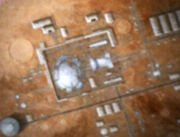
Galaxy class ship under construction at Utopia Planetia
Major component construction of Galaxy-class ships was carried out both in orbit and at ground based facilities.
- Although the Star Trek: The Next Generation Technical Manual portrays a long, drawn-out construction history of the Galaxy-class, TNG: "Booby Trap" and "Eye of the Beholder" seem to suggest that the ships were designed and placed into service rather quickly, as final systems were designed only one year prior to the launch of the Enterprise-D. The ship itself was still under major construction one year prior to TNG: "Encounter at Farpoint".
Upon its launch, the Galaxy-class became the most technologically sophisticated and complicated ship ever built by the Federation. (TNG: "Lonely Among Us", "Contagion")
Early years
The great size and capability of Galaxy-class starships made them extremely prestigious assignments, attracting Starfleet's best and brightest. (TNG: "Ménage à Troi"; VOY: "Relativity") They were noted for their impressive abilities among Federation citizens and other Alpha Quadrant races. (TNG: "Tin Man", "Chain of Command, Part I"; DS9: "Valiant"; VOY: "Infinite Regress") The Galaxy-class was unique among Starfleet vessel designs in assuming a large civilian population; many personnel brought their families aboard.
In 2365, the safety of the Galaxy-class, in particular its warp propulsion system, came into question when the USS Yamato was lost in a mysterious accident near the Romulan Neutral Zone. The ship had experienced massive systems-wide failures which eventually led to a loss of antimatter containment. Further investigation by the Enterprise-D revealed the malfunctions were as a result of an Iconian software transmission and not a design flaw inherent to the ship. (TNG: "Contagion")
Undoubtedly the most prominent early Galaxy-class starship was the USS Enterprise-D, which apart from two brief periods under the command of William T. Riker and Edward Jellico was commanded for its entire nine year career by Captain Jean-Luc Picard. Enterprise made first contact with a multitude of new species, including the Q Continuum, the Ferengi Alliance and the Borg Collective. Its diplomatic efforts helped cool tensions between smaller, regional powers and prevent dramatic upheavals to the security of the Federation during the Klingon Civil War, and frequently checked Romulan and Cardassian operations in tense situations. It fought off some of the Federation's toughest foes, preventing the assimilation of Earth during the Borg invasion of 2367. (Star Trek: The Next Generation)
Dominion War
The USS Odyssey is destroyed
A Galaxy-class ship was involved in the disastrous first contact with the Dominion. The USS Odyssey had entered the Gamma Quadrant in order to rescue several Federation citizens who had been taken captive by the Jem'Hadar. While the Odyssey was retreating, a Jem'Hadar attack ship made a suicide run at its stardrive section, causing a massive hull breach and the complete destruction of the ship. (DS9: "The Jem'Hadar") This unwarranted act led to three years of hostilities between the Federation and the Dominion, before the outbreak of the Dominion War.
Galaxy-class starships saw action in many of the major fleet actions of the war, including Operation Return, where the class also played a major strategic role, grouped into Galaxy wings, (DS9: "Sacrifice of Angels") the first Battle of Chin'toka, (DS9: "Tears of the Prophets") and the Battle of Cardassia. (DS9: "What You Leave Behind")
- Analysis of the special effect shots from "Sacrifice of Angels" showed no less than five, possibly even nine separate Galaxy-class vessels in the combined Federation fleet in Operation Return. While the intention of the SFX company was clearly to fill the space with more ships (due to the supposed fleet size of roughly 600 vessels), this would indicate that there are perhaps more than the initial six Galaxy-class starships referenced in the TNG Technical Manual. It is also stated within the Technical Manual that Starfleet had reserved parts that could complete another six Galaxy-class starships. These parts could have been rushed into assembly to fill the ranks of the fleet for wartime use or to replace the losses at Wolf 359. With a total of twelve Galaxy-class ships produced and the known loss of the USS Enterprise-D, USS Yamato, and the USS Odyssey, this leads to a count of nine ships in the fleet. If the ships seen during that battle do not represent the entire Galaxy-class fleet, there could possibly have been more than either six or nine.
The USS Galaxy at the First Battle of Chin'toka
Later status
Several more starships entered the fleet inventory during the 2370s. (VOY: "Relativity") By the latter half of the decade, Galaxy-class ships were seen all around Federation space, from stations near Earth (VOY: "Endgame") to near the Romulan Neutral Zone. (Star Trek Nemesis)
- At least three, possibly four, Galaxy-class ships were shown under construction at Utopia Planitia during VOY: "Relativity". At least five, possibly seven, Galaxy-class ships were part of the fleet assembled to intercept the Borg sphere in VOY: "Endgame".
- In alternate future timelines, Galaxy-class ships were in service as late as 2395. (TNG: "All Good Things...")
Technical data
Physical arrangement
Saucer separation in progress
The Galaxy-class had two hull sections, a saucer-shaped primary hull and a secondary hull which mounted the two warp nacelles. The hulls were capable of reversible saucer separation and were both equipped with independent flight and combat capabilities. Generally, civilians and non-essential personnel would evacuate to the saucer module, while the senior staff confronted a threat in the battle section, which contained the majority of weapons systems. (TNG: "Encounter at Farpoint") The saucer was even capable of crash-landing on a planetary surface. (Star Trek Generations)
- Although children appeared to be evacuated from the star drive section in Generations, Ronald D. Moore commented: "I believe the children were actually being rushed to their "crash stations" or "emergency stations" or something, not being brought up from the battle section. The same goes for the patients in sickbay." [1]
The hull of the Galaxy-class was left somewhat customizable; areas such as Deck 8 were designated as unfinished and multi-purpose, in the event that extra space was needed for a specific mission. (TNG: "Liaisons")
- According to the non-canon but Memory Alpha permitted resource Star Trek: The Next Generation Technical Manual, when the Enterprise-D was initially launched from Utopia Planitia, a full 35% of the the customizable space was left empty, to be later filled with individual modules as seen fit.
Command and control systems
The computer system on board the Galaxy-class was isolinear based. (TNG: "The Naked Now") Computer systems were concentrated in a computer core, which was accessible through a maintenance room. (TNG: "Evolution") Each Galaxy-class vessel carried a total of three independent computer cores; two located in the saucer section and one in the engineering section.
- According to the non-canon but Memory Alpha permitted resource Star Trek: The Next Generation Technical Manual, all of the ship's essential computer processing functions maybe handled by a single core.
Propulsion systems
Impulse engine (aft torpedo launcher is also visible)
Galaxy-class ships achieved warp flight through two warp nacelles, which housed multiple pairs of warp coils. (TNG: "Eye of the Beholder") Maximum speed was warp 9.6, which could be maintained for approximately twelve hours. (TNG: "Encounter at Farpoint", "The Best of Both Worlds") The warp core was one of the most powerful in Starfleet. In benign situations, it generated approximately 12.75 billion gigawatts of power. (TNG: "True Q") The efficiency of the warp drive could be tweaked to a point where it rivaled the new Template:ShipClass ships introduced in 2370. (TNG: "Force of Nature")
The warp core spanned twelve decks in the engineering hull. The deuterium tanks were above the core, while antimatter storage pods surrounded the base of the core on Deck 42. (TNG: "Liaisons")
There were three impulse engines, two on the saucer section and one in the stardrive section. In early ships, only the impulse engine in the stardrive section was usually active.
Upgrades

The navigational deflector dish of a Galaxy-class starship
Upgrades to the propulsion systems were tested in 2370 aboard the Enterprise-D; the ship received a new warp core manufactured with interphase technology. (TNG: "Phantasms") A major rehab of the nacelles was also conducted that year. (TNG: "Eye of the Beholder") By the mid 2370s, most Galaxy-class ships began operating with all three impulse engines activated. (DS9: "Favor the Bold"; VOY: "Timeless")
Scientific systems
Galaxy-class ships supported a wide variety of scientific equipment and laboratories studying many different disciplines. (TNG: "Liaisons") The departments often had to compete for limited resources such as sensor time, which were allocated by the operations manager or, on occasion, the executive officer. (TNG: "Lessons")
Upgrades
Sensor systems could be customized and upgraded as necessary for a specific mission. Additional equipment could be added as required. (TNG: "Cause and Effect", "Schisms") The latest technologies were generally outfitted to Galaxy-class ships as they left the experimental stages. (TNG: "All Good Things...")
Tactical systems
A Galaxy-class starship fires its phasers
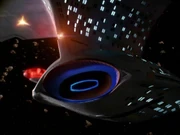
A Galaxy-class starship's forward torpedo launcher
The Galaxy-class was equipped with twelve phaser banks, located at various points along both hulls, although one array was located on the dorsal of the battle section and could only be used following a separation. There were also fore and aft torpedo launchers on the engineering section. (TNG: "Conundrum") Each launch tube was capable of firing up to ten photon torpedoes simultaneously, each torpedo capable of being independently targeted. (TNG: "The Arsenal of Freedom", "Yesterday's Enterprise") In the 2360s, Galaxy-class ships typically carried about 275 photon torpedoes. The torpedo launchers were also capable of handling probes. The Galaxy-class also supported a high-capacity deflector shield grid. (TNG: "Conundrum")
- While "Conundrum" establishes that there were only ten phaser banks aboard the ship, a visual inspection shows twelve. The saucer launcher was never established in dialog, but is visible on the filming model.
Upgrades
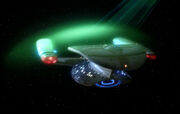
The deflector shields of a Galaxy-class starship's secondary hull
The Enterprise-D received weapons systems upgrades in 2370, including a loadout of higher-yield photon torpedoes and enhanced targeting sensors programmed by Lieutenant Worf. (TNG: "Genesis") Certain Galaxy-class ships, such as the USS Venture, were refit with additional phaser strips on the dorsal surfaces of their nacelles by 2372. (DS9: "The Way of the Warrior")
- This modification is an artifact left over from the changes made to the four-foot Enterprise model for TNG: "All Good Things...", although the "bumps" containing the phaser arrays on the Venture seem to have been rotated a full one-hundred eighty degrees from those on the Enterprise-D. The Venture was the only ship to have these modifications; none of the CGI Galaxy-class ships used exclusively since the fifth season of DS9 (including the Venture itself) are modified in such a manner.
Crew support
While Starfleet policy permitted the immediate family of officers and crew to stay aboard starships prior to the advent of the Galaxy-class, it was the first class specifically tailored to accommodate civilian as well as Starfleet personnel. (TNG: "Encounter at Farpoint") Civilians were allowed to hold varying positions in the science division aboard the Galaxy-class. (TNG: "Night Terrors")
- Regarding the presence of families on starships, Ronald D. Moore commented "Perhaps [still] on some Galaxy-class ships, but I think this was an experiment that failed." [2] "I think that the "family friendly" starship notion was an interesting idea, but one that didn't pan out. There was always something awkward about Picard ordering the ship into battle situations with kiddies running through the corridors. And no matter how much lip service we paid to the "our families are part of our strength" concept, it never seemed very smart or very logical to bring the spouse and kids along when you're facing down the Borg, or guarding the Neutral Zone, or plunging the ship into uncharted spatial anomalies." [3]
Interior design
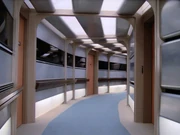
A typical saucer section corridor
With the presence of families and non-Starfleet personnel aboard, the Galaxy-class interior was mostly designed for their comfort and the well being of the crew in general. While the major command sections maintained form and functionality above all, there remained a much more "relaxed" feel about the design of many of these areas.
- In Star Trek Generations, the interior lighting scheme of the Enterprise-D was noticeably darkened.
Main bridge
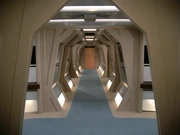
A corridor in the engineering section
The main bridge, fore starboard view
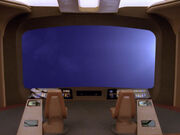
The ops and conn consoles
The main bridge of the Galaxy-class was located on Deck 1 of the saucer section. As with most starships, the main bridge was modular and could be completely replaced with another bridge if the need called for it. Different Galaxy-class starships had different bridge designs. The following describes the bridge design used in at least two Galaxy-class starships, including the USS Enterprise-D.
- The theory of different bridge designs for different Galaxy-class starships comes from DS9: "The Jem'Hadar", where the USS Odyssey featured a completely different bridge design from that of the USS Enterprise-D.
The forward bulkhead was dominated by the main viewscreen. Directly behind this were the operations manager and conn positions. At the very center of the room was the command area – the captain's chair at the center, flanked by chairs for the first officer to the right, and an additional officer (typically the ship's counselor or chief medical officer) to the left. Smaller backless seats were located on the edges of the command area, for other officers to sit, should the need arise.
- In the pilot, as well as early in the first season, the forward bridge consoles don't seem to be dedicated specifically to either helm control or operations since Data, the operations manager, can be seen in both the left and right stations at different times.
The tactical console, positioned directly behind the captain, was located in the wooden handrail that encircled the rear half of the central command area. The aft bulkhead carried several additional consoles. These could be customized as needed (TNG: "Chain of Command, Part I") and were reconfigured at least twice. In 2364, the consoles, from starboard to port, were Science I, Science II, Environment, Emergency Manual Override, and Propulsion Systems. By 2365, they were Science I, Science II, Mission Ops, Environment, and Engineering. The stations featured pullout seats below the console, which were normally flush with the panel below the stations. The bridge was also equipped with two food replicators.
By necessity, the bridge had easy access to and from all other important areas of the ship. In all, there were six doors leading from the room. Moving clockwise from the main viewscreen, the first door, level with, and to the right of the conn, lead directly to the battle bridge emergency turbolift. At the rear right of the bridge, a shallow alcove contained two doors, one of which contained a head, the other to a corridor leading to the observation lounge. The door at the rear right of the room opened onto a standard turbolift. Continuing around, the fifth door lead into the captain's ready room, the sixth to another turbolift. (TNG: "Encounter at Farpoint")
As the main bridge housed so many critical systems, numerous emergency environmental and power backups were included so that duty personnel could continue to work for up to 72 hours in the event of a major shutdown or incapacitation of the vessel. Other safeguards included seven redundant safety interlocks to prevent the life support from being turned off on the bridge. (TNG: "Brothers")
Upgrades
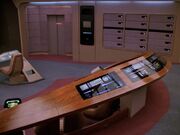
The security station, integrated in the wooden handrail
The bridges of Galaxy-class ships were subject to several minor cosmetic changes over their first decade of service. The first major refit came in 2371 as seen aboard the USS Enterprise-D. Six new stations were added, three on each side of the bridge replacing the equipment lockers. The aft stations were accordingly reprogrammed and moved to different locations. The three starboard stations were designated Science I, II, and III. Science IV became the first aft station, followed by Mission Ops, Environment, and Engineering I/II. The port side of the bridge had three communications stations, consoles which were not common to the bridges of 24th century ships. In addition, the command chairs were raised two steps above the helm and ops stations, to provide the captain with an unobstructed view of the forward viewscreen. New carpeting and handrails were also added. (Star Trek Generations)
Observation Lounge
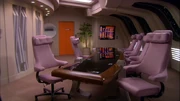
The observation lounge
The observation lounge was located directly behind the main bridge. The room was usually used as a conference room for the vessel's senior staff. It featured large, aft-facing windows that offered a spectacular view of the back of the starship and space beyond. A conference table with seating for ten people was the main feature of the room, (TNG: "Encounter at Farpoint") with LCARS screens on the port and starboard walls for information displays and retrieval. (TNG: "The Child") Holographic emitters embedded within the table could also be used for presenting data. (TNG: "The Last Outpost") Some starships featured artwork along the wall opposite the windows; when this was not present the bare wall showed several structural supports. (TNG: "Darmok")
Battle bridge
The battle bridge
The battle bridge was located on Deck 8 and was connected to the main bridge and other vital areas of the ship by an emergency turbolift. It was designed to control the stardrive section following a saucer separation. Unlike the main bridge, there was much more focus on combat and tactical systems and no science stations. The battle bridge was modular like the main bridge; at least two variants have been seen aboard Galaxy-class ships. (TNG: "Encounter at Farpoint", "The Best of Both Worlds, Part II")
Main engineering
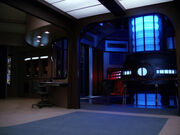
Main engineering
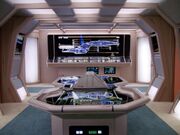
The "pool table" and the MSD
Engineering systems spanned twelve decks of the engineering section. Engineering itself was located on Deck 36 (TNG: "Liaisons") and was an open-plan facility, directly accessible from the corridor. Consisting of two levels, it provided direct access to the vessel's warp core and primary engineering support systems. The corridor bulkhead housed the Master Situation Monitor. Inside the main section, the master systems display, affectionately known as the pool table, was the operational focus of the room. Beyond this, heading towards the warp core, the chief engineer's office and several support consoles were located on the left, and the assistant chief engineer's console on the right. These formed part of the bulkhead protecting the main part of Engineering from the warp core. Access to the upper level, a circular area surrounding the warp core, was provided by a ladder to the left of the warp core or an elevator on the right. The upper level had access to other warp core maintenance systems. (TNG: "The Dauphin", "The Best of Both Worlds, Part II")
Engineering could also serve as a backup to the main bridge if it was damaged or disabled. (TNG: "Brothers")
In the event of a major failure, such as an imminent warp core breach, engineering was equipped with isolation doors and forcefields to contain various sections of the facility, usually to seal off the warp core prior to detonation or ejection. (TNG: "The Best of Both Worlds", "Violations"; Star Trek Generations)
Medical facilties
The Galaxy-class medical department was charged with providing health care to the ship's company and all attached personnel.
Sickbay
Intensive care unit
There were at least three sickbay wards aboard the ship, (TNG: "Tapestry") with at least one in the saucer section (TNG: "Genesis") and another in the stardrive section. (TNG: "The Arsenal of Freedom") There were four recovery biobeds on the periphery of the room with a main surgical biobed opposite them, covered by a large overhead sensor cluster and capable of hookup to a surgical support frame. Equipment storage and various control panels were located throughout sickbay. The chief medical officer's office was a small space just off of the main sickbay, with desk and workspace for the CMO. A small foyer connected the office to the sickbay; it contained a replicator terminal.
Separate, private recovery rooms were also located near sickbay (TNG: "Ethics") as was a nursery (TNG: "Home Soil", "Data's Day") and a diagnostic center. (TNG: "Transfigurations")
A Galaxy-class sickbay also had the facilities to isolate parasitic protoviruses. (TNG: "Brothers")
Medlabs
The CMO's office
Galaxy-class ships had at least four medical laboratories of varying sizes. There was a small laboratory accessible through the foyer outside the chief medical officer's office where minor experiments run by on-duty personnel could be monitored. (TNG: "Home Soil", "Evolution", "Clues", "The Game") Other larger medlabs similar to standard science labs were elsewhere. (TNG: "Ethics")
Surgical suite
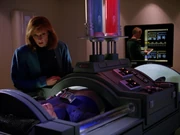
The emergency bio support unit
Surgeries too complicated for the sickbay ward could be conducted in a separate surgical area which had a large variety of bio support systems. (TNG: "Ethics")
Emergency bio support unit
There was a separate room located near the main sickbay facility on Deck 12 that contained the emergency bio support unit. Patients with severe burn injuries could be treated here in a closed cell. (TNG: "Transfigurations")
Morgue
A morgue facility with storage slots for several bodies was located adjacent to sickbay. (TNG: "Man of the People", "Suspicions")
Counselor's office
The ship's counselor had his or her own office, located on Deck 9. Crew members needing emotional support could meet in privacy with the counselor here. (TNG: "The Price")
Scientific department
The Galaxy-class starship housed over one hundred separate scientific research labs. Very few of the research labs remained under the same discipline of science for more than six months. Most shared the same design; only a few had extremely specialized equipment.
Stellar cartography
The vessel also housed a stellar cartography department, located on Deck 9. There were at least two laboratories based there; one, a smaller facility similar to the other labs aboard the ship; another, a much larger cylindrical room spanning three decks. The walls of the room were designed to be a three-dimensional display. (Star Trek Generations)
Cybernetics lab
Cybernetics lab
Aboard the Enterprise-D, the cybernetics lab was a circular room, with a raised platform in its center containing a shell which could hold a cybernetic body. The entire assembly could retract into the ceiling and was directly controlled by a console to the side. There were additional wall-mounted consoles throughout the room. (TNG: "The Offspring") The laboratory was redesigned in 2368 and altered to become much more rectangular, although it still featured the shell assembly. (TNG: "I, Borg", "The Best of Both Worlds, Part II")
Arboretum
The arboretum was capable of studying and supporting a wide variety of plant life, and also doubled as a social area. (TNG: "Night Terrors", "Imaginary Friend", "Dark Page")
Cetacean labs
The Galaxy-class starship carried a complement of cetaceans. Among the crew, these facilities were also known as "the dolphin tanks" (TNG: "The Perfect Mate") or the "aquatic lab." (TNG: "Genesis") In an alternate timeline, these facilities were also known as Cetacean Ops. (TNG: "Yesterday's Enterprise")
- These labs are shown in the saucer section in the Star Trek: The Next Generation USS Enterprise NCC-1701-D Blueprints and are mentioned in the TNG Technical Manual. While the area itself was unfortunately never seen on the show, their existence has been confirmed in dialog.
Transport and cargo
Transporter rooms
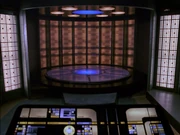
Transporter room
Galaxy-class starships had twenty transporter rooms located throughout the vessel. (TNG: "11001001") Four transporter rooms were located on Deck 6 of the saucer section, (TNG: "The Game") while two more were on Deck 14 of the stardrive section. (TNG: "Encounter at Farpoint")
Shuttlebays
Main Shuttlebay, external view
There were three shuttlebays aboard each Galaxy-class starship, supporting many varieties of shuttlecraft. The main shuttlebay was located on Deck 4 in the saucer section. It was so massive that an explosive decompression of the air within the bay would contain enough force to propel the ship forward. (TNG: "Cause and Effect") Two smaller shuttlebays were on Deck 13 of the engineering hull. (TNG: "The Next Phase")
- The main shuttlebay would have been prohibitively expensive to build as an actual set, and was only seen in miniature form during TNG: "Cause and Effect". During the first few seasons of Star Trek: The Next Generation, Shuttlebays 2 and 3 were erroneously shown on Deck 11.
Embarked craft
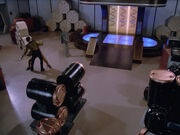
A typical cargobay
- type-6 shuttlecraft (TNG: "Darmok")
- type-7 shuttlecraft (TNG: "Coming of Age")
- type 15 shuttlepod (TNG: "Time Squared")
- Template:ShipClass runabout (DS9: "Emissary")
- captain's yacht
Cargo bays
There were numerous multi-level cargo bays located all throughout the ship. Most of these bays contained sufficient room for storage, cargo transporters, and anti-grav units for the transportation of cargo. (TNG: "The Hunted", "Hollow Pursuits") Cargo bay four was the only cargo bay with direct access to the exterior hull. (TNG: "Power Play")
Crew quarters
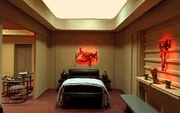
Junior officers' quarters
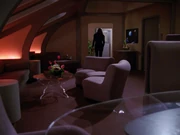
Standard officers' quarters
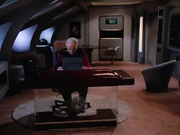
Luxurious VIP quarters
Most crew quarters on the Galaxy-class were located in the ship's saucer section, in order to provide safety for civilian and non-essential personnel during a saucer separation. However, the engineering hull also contained crew quarters, generally containing engineering personnel and their families. (TNG: "Imaginary Friend"; Star Trek Generations) Pets, including cats and dogs, were also allowed aboard ship. (TNG: "Data's Day")
There were several types of crew quarters aboard:
- Junior officers' quarters - These small quarters units were located on the interior of the ship and lack windows. They were comprised of a living area, a bedroom, and a bathroom. Crewmembers of Lieutenant Junior Grade were given their own quarters; ensigns were required to share quarters. (TNG: "Lower Decks") The living area contained a replicator terminal and was customizable with a variety of furniture and decorations.
- Officers' quarters - These quarters lined the edge of the saucer section and contained a living area, a bedroom, and a bathroom area. (TNG: "Schisms", "Frame of Mind", "Genesis") They were generally reserved for lieutenant commanders and above. Similar quarters were also available to enlisted and civilian personnel with families. (TNG: "The Wounded")
- Captain's quarters - The captain's quarters, located on Deck 8, were similar to the officers' quarters but were slightly larger. The captain had a large desk area and work terminal. VIP and diplomatic guest quarters shared the same layout. (TNG: "Too Short a Season", "Sarek")
Recreational facilities
Ten Forward
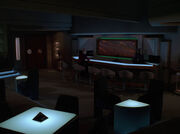
The Ten Forward lounge
Located at the forward most section of the saucer module on Deck 10, Ten Forward served as the social center of the ship. It had a battery of recreational games including three-dimensional chess as well as a fully stocked bar which carried syntheholic beverages. The replicators were also able to produce other food and drinks for the crew to enjoy in a relaxed social setting. Its large, panoramic windows permitted a staggering view of the ship's passage through space. (TNG: "The Child", "Power Play")
- To date, Ten Forward has only been shown on board the USS Enterprise-D. However, there is no evidence proving that it was not a feature of every Galaxy-class ship. Given the extended duration of their missions, it is likely that designers included this feature on her sister ships to serve their recreational and social needs as well. In the novel The Return, Ten Forward is replaced by "Shuttlebay Four".
Holodeck
The Galaxy-class carried sixteen holodecks, which are located on Decks 9, 10 and 11. (TNG: "11001001", "Homeward")
Phaser range
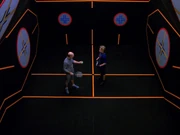
The racquetball court
The phaser range was located on Deck 12. A person stood on a platform in the center of the room, illuminated only by the light which came from above the platform. Colored circular lights, approximately the size of a Human hand, whirled across the walls, and the person aimed and fired at selected targets. After completing a round, the number of hits and misses, along with the percentage of accuracy, were tallied by the ship's computer. There were at least fifteen levels of difficulty, and the range could be customized for two-player competition.
The phaser range was also used by security officers to train personnel in marksmanship. (TNG: "A Matter Of Honor", "Redemption II")
Gymnasium
The fencing room
The gymnasium, also on Deck 12, contained a variety of recreational equipment for a variety of sports. In addition to aerobic studios (TNG: "The Price") and martial arts areas (TNG: "Clues", "Second Chances"), there was a parrises squares area (TNG: "Second Chances"), a squash court, (TNG: "Suddenly Human") and an anbo-jytsu court. (TNG: "The Icarus Factor") The gymnasium also featured a fencing room. Aboard the Enterprise-D, Captain Picard usually fenced with fellow crewmembers. (TNG: "We'll Always Have Paris", "I, Borg")
Theater and Concert Hall
The theater and concert hall
There was a large theater aboard, which was equipped to seat large groups of people. The theater could also be used as a concert hall for musical performances by crew members. (TNG: "Sarek", "Frame of Mind")
- The theater set was a reuse of the Ten Forward set.
Salon
The salon was an area where crewmembers could get personal care ranging from a simple haircut to an elaborate spa-like treatment. (TNG: "Data's Day", "The Host", "Schisms")
Replimat
At the replimat, crewmembers could replicate items which were too large or complicated for a standard food replicator terminal. They could "shop" for certain items by reviewing the fabrication database. (TNG: "Data's Day")
Educational facilities
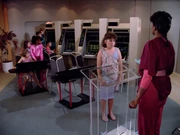
A small school
There were several small schools of varying sizes located throughout the ship, ranging from actual classrooms (TNG: "When The Bough Breaks") to specialized workshops. (TNG: "Imaginary Friend", "Rascals", "Masks")
Ships commissioned
- Named
- USS Challenger (NCC-71099)
- USS Enterprise (NCC-1701-D)
- USS Galaxy (prototype, NCC-70637)
- USS Odyssey (NCC-71832)
- USS Venture (NCC-71854)
- USS Yamato (NCC-71807)
- Unnamed
Appendices
Appearances
- TNG:
- The Galaxy-class USS Enterprise-D appears in every episode.
- Other than the Enterprise-D:
- Star Trek Generations
- DS9:
- VOY:
- "Non Sequitur" (model)
- "In the Flesh" (wall display)
- "Timeless"
- "Relativity"
- "The Voyager Conspiracy" (on astrometrics screen)
- "Endgame"
- ENT: "These Are the Voyages..."
Background
The Galaxy-class starship was first seen as the USS Enterprise-D. It was designed by Andrew Probert. Interiors were supervised by Herman Zimmerman in the first season of TNG and Star Trek Generations, and Richard James for the subsequent six seasons.
| File:Probert Enterprise sketch.jpg | |
| File:Probert Enterprise drawing.jpg |
When it came time to design a new starship Enterprise for The Next Generation, history did not repeat itself. Where Matt Jefferies had produced hundreds of sketches to come up with the design direction for the original Enterprise, Andrew Probert's main design work for the new Enterprise was done before his job even started.
Before the series was announced, Andrew Probert painted the lower illustration on the right of a future starship concept, strictly for his own enjoyment. When he went to work on the Paramount lot to design the new Enterprise, he brought that painting with him as inspiration and hung it on his office wall.
One day, David Gerrold came into Probert's office, saw the painting, and asked if Gene Roddenberry has seen it. Probert said he hadn't, and Gerrold immediately took it in to Roddenberry, who approved the painting's design direction on the spot. All that remained was fine-tuning and filling in the details.
Gene Roddenberry asked only for two modifications to Probert's final design. He wanted to restore the bridge to its position on the top of the saucer section and to extend the nacelles so that they had similar proportions to the original Enterprise.
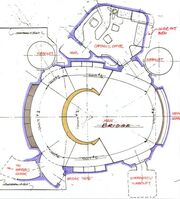
Floor plan

Final bridge design
Andrew Probert made a series of drawings refining the new look for the Enterprise's bridge. An early writers' bible for the new series described the new bridge as combining "the features of ship control, briefing room, information retrieval area, and officers' wardroom. In other words, much the same kinds of things happen here as in the old bridge, but with less emphasis on the mechanics of steering the starship."
That new, less mechanistic approach can be seen in the preliminary designs featuring viewing couches and a conference table on the bridge.
Technical specifications for the Galaxy-class were visible on a display in the conference lounge of the Enterprise-D beginning with the episode TNG: "Chain of Command, Part I".
- On a side note, a four-foot model of the Enterprise-D was re-labeled as the USS Trinculo (NCC-71867). It was displayed at a restaurant, and never appeared in an episode.
Technical Manual
The Star Trek: The Next Generation Technical Manual and the Star Trek: The Next Generation USS Enterprise NCC-1701-D Blueprints shows that the Galaxy-class was equipped with a third torpedo launcher that was exposed upon the saucer separating from the battle section.
The Star Trek: Deep Space Nine Technical Manual lists the class' statistics as follows:
- Type: Explorer
- Production Base: ASDB Integration Facility, Utopia Planitia Fleet Yards, Mars
- Accommodation: 1,012 officers and crew; 200 visiting personnel; 15000 personal evacuation limit
- Power Plant: One 1,500+ Cochrane warp core feeding two nacelles; one impulse system in stardrive section, two impulse systems in saucer section
- Dimensions:
- Length: 641 meters
- Beam: 463.73 meters
- Height: 195.26 meters
- Mass: 4,500,000 metric tons
- Performance: Warp 9.6 for 12 hours (STD); warp 9.9 for 12 hours (Uprated)
- Armament: Eleven type-X phaser emitters; two photon torpedo launchers
While the Technical Manuals themselves are not canon, they are Memory Alpha permitted resources.
Apocrypha
- In the Star Trek: Armada series of computer games, the Galaxy-class is referred to as a battleship in gameplay. On screen, the USS Enterprise-D has been casually referred to as a battleship in TNG: "Yesterday's Enterprise" and "All Good Things...". However, these instances take place in Alternate timelines and it is not known if "battleship" is an actual starship type within Starfleet.
- In Peter David's "New Frontier" line of novels, Captain Calhoun and crew are given a Galaxy-class replacement for the lost Template:ShipClass USS Excalibur. It is notable for also possessing a designation as the Excalibur-A, something only previously seen with Kirk's USS Enterprise.
- Although not considered canon, the following Galaxy-class starships have been mentioned in novels and games:
- USS Allegheny (Star Trek: Armada II)
- USS Asgard (A Time to Be Born)
- USS Bolivar (Rogue Saucer)
- USS Breedlove (Star Trek Invasion: Time's Enemy)
- USS Challenger II (The Return)
- USS Cheyenne (NCC-75435) (Star Trek: Borg)
- USS Constitution (Double Helix: Infection; Possession)
- USS Dauntless (NCC-71879) (Star Trek: Bridge Commander) (destroyed in battle)
- USS Excalibur-A (Excalibur: Restoration et al.)
- USS Hood (Station Rage)
- USS Idaho (The Big Game; The Long Night; Star Trek Invasion: The Soldiers Of Fear)
- USS Madison (The Big Game; The Long Night; Star Trek Invasion: The Soldiers Of Fear)
- USS Monitor (Star Trek: Away Team) (assimilated)
- USS Muakaikubo (Star Trek Invasion: Time's Enemy) (destroyed in battle)
- USS Oraidhe (Intellivore)
- USS Oregon (NCC-75698) (Star Trek: Armada)
- USS Potemkin (Station Rage)
- USS San Francisco (NCC-74780) (Star Trek: Bridge Commander)
- USS Trident (Gateways: Cold Wars et al.)
External links
- Designing the next generation Enterprise at Forgotten Trek
- Designing the Enterprise-D at Federation Starship Datalink
Revision ID missing! • Date missing! • Blurb
